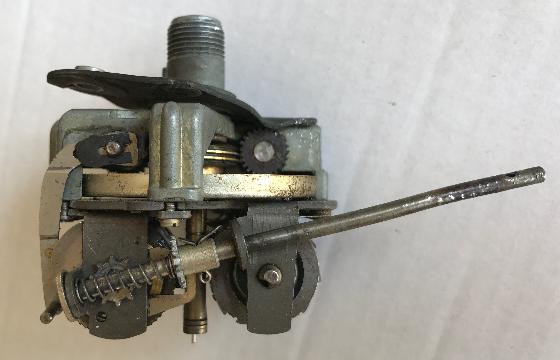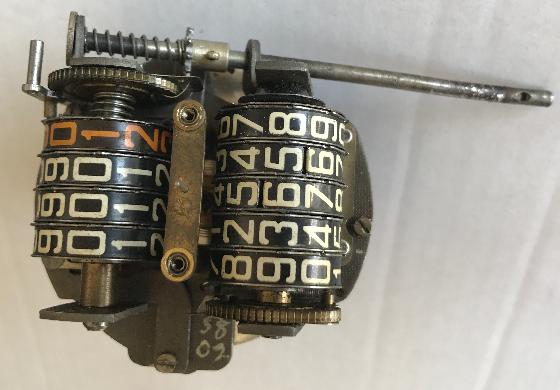The MGA With An Attitude
SPEEDOMETER TECH -- ST-101
ST-101 concerns how travel down the road induces motion into the rotary cable driving the dash instrument, and how the internal mechanics of the speedometer work.
Speedometer registration begins with the tire size, which determines the number of revolutions per mile of travel. The original tire size for your MGA was a 5.60-15 bias ply nylon tire. These tires are generally no longer available, except on special order through a classic tire dealer at about twice the price of the modern radial tire equivelant. The nearest radial tire size to this is 155R15, which is similar in width and appearance, but with a different tread pattern and a slightly lower aspect ratio, so it will be a little smaller in overall diameter, increasing both your speed and distance readings by about 2.5%. The next size up, 165R15 (just 0.4" wider), is nearly an exact match to the proper overall diameter to make your odometer read correctly, and is a more widely available tire size as well.
The nominally correct overall rolling diameter for a tire for your MGA is 24.92" to make the odometer read correctly. I have in prior years used Dunlop SP4n 165R15 tires, but they went out of production about 1996. I switched to the newer Dunlop SP20 165R15 tires with the same good results in handling and the same results in rolling diameter. With the proper inflation pressure these tires can be made to roll at exactly the correct diameter to make your odometer accurate (at least when the tires are new). I use a rally computer which is accurate to +/- 1 foot per mile to measure rolling distance. I find that at 25psi these tires (when new) will register 100.4 miles on the MGA odometer in 100 miles of travel. Increasing the tire pressure by 3 or 4 PSI can get the MGA odometer to register 100.0 miles in 100 miles of travel. After you wear 1/8" of rubber from the radius of the tire tread, the odometer will register about 1% greater distance, and the speedometer reading will also increase by 1% (along with engine speed). The SP20 tires are also now out of production. I have been ising Kuhmo tires in the same size (165R15) since 2002.
The 24.92" rolling diameter of the tire translates into 809.30 turns per mile of travel. Multiplying by the final drive ratio of 43/10 (4.300:1) gives the drive shaft 3480.0 turns per mile. Further multiplying by the 5/12 ratio of the speedometer take off gear in the tail of the transmission gives the speedometer cable 1450.0 turns per mile. You should find the number 1450 on the face of your speedometer, indicating the number of turns required to make the odometer register exactly one mile.

Inside the speedometer, the first reduction is driven with a large diameter worm gear with a lead of one tooth per revolution. This worm gear drives a small fiber gear with 25 teeth (for the MGA), affecting a reduction ratio of 25:1, giving that gear and shaft a rotation of 58 turns per mile. (A common cause of failure in these odometers is the shearing off of a few teeth from the fiber gear. - Click for picture and repair.) On the opposite end of that shaft is an eccentric stub shaft that carries a spring loaded ratchet pawl. Each turn of the shaft causes the ratchet pawl to advance the "final" gear one tooth. That final gear is mounted on the odometer shaft to drive the first odometer wheel (by side friction) and has 58 teeth (for the MGA 1500/1600 models), so the 58 rotations of the eccentric shaft will advance the first odometer wheel odometer exactly one turn in one mile of travel. Both the main odometer and the trip odometer use similar mechanisms, so inside the instrument you will find two complete sets of the odometer drive parts (after the first worm drive gear).
Also, as a matter of curiosity, that ratchet pawl continues to trace out a similar motion when the car is moving in reverse. So, the odometer cannot be made to run backwards by driving backwards. I would think the odometer would continue to run forwards when the car is going backwards, but as I recall, it doesn't, it just stops turning. I seem to have tried this in a rally once.

In between the number wheels of the odometer are friction disks that will turn the next wheel in line. Each of the number wheels has a driven disk with ten ratchet type teeth on the input side, and a small spring finger catches on to those teeth to prevent rotation of the wheel (except of the first wheel being driven by the input ratchet gear). Each of the number wheels also has a disk with one ratchet type tooth on the output side of the wheel, with the ramp of this tooth being reversed from the orientation of the teeth on the input side of the wheel. As the number wheel completes each rotation, the tooth on the output side of the wheel lifts the spring finger to release the next wheel in line so it is free to rotate, and the next wheel will then advance 1/10 turn (one digit) to where it will again catch a tooth on the spring finger and be stopped and held in place. Each number wheel in turn drives the next wheel in line to affect the sequential stepping of the odometer. The main odometer does not have the 1/10 mile number wheel, but it does have the one tooth disk that will trip the first number wheel for each mile of travel.
The speedometer (indicating needle) is driven by a much simpler mechanism. On the input shaft (which is driven by the flexible speedometer cable) there is a disk which carries a small bar magnet which rotates similar to a propeller. This magnet rotates inside of a flat aluminum (electrically conductive but non-magnetic) pan with a cylindrical edge like a miniature cake pan. As the magnet rotates it induces electrical eddie currents in the aluminum pan, which in turn give rise to a magnetic field in (or around) the aluminum pan. The interaction of the bar magnet with the magnetic field in the pan induces a torque on the pan which increases with the speed of rotation of the bar magnet. This torque drives the shaft that the pan is mounted on, which in turn drives the speedometer needle mounted on the other end of that shaft. Attached to the shaft is a multi-turn clock spring that resists rotation of the shaft. The counter balance between the driving torque of the spinning magnet and the resistance of the clock spring is such that the indicating needle moves around the dial roughly proportional to the speed of the input shaft, indicating your speed of travel.
Speedo Tech 102 covers causes of errors and some not so difficult calibration of the speedometer.
Barney Gaylord
|